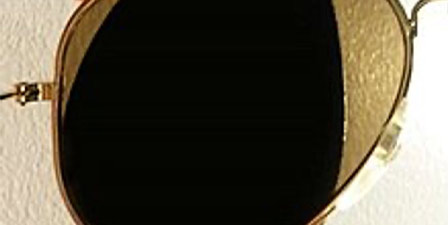
By Alan Taylor, L.O.
REFLECTIONS ON ANTI-REFLECTIONS
We’re at the nearby deli talking shop over corned beef, and my optical colleague Fred, who apparently loves the fries off my plate, is posing another chatty question I cannot immediately answer.
“Did you ever notice how the word ‘anti-reflective’ is kind of a double negative?” Fred asks.
“No,” I say. “Because it’s not.”
“But anti-reflective sounds like a double negative,” he insists. “And it’s confusing! Is it not?”
I play along. “How so?” I ask.
“C’mon,” says Fred. “Anti-reflection?” He slowly steals three fries off my plate, as though each fry represented each syllable: “Anti-re-flection,” he says as he eats. “You’ve got two opposing prefixes—‘re’ and ‘anti.’”
I tell him he’s overthinking this and ask if he would please stop taking fries off my plate.
He’s busted. He returns two fries, but he will not be silenced. He means well, but his pedantic instincts can’t help themselves, and so he goes on to explain how the Greek root anti—anti with an “i” (not to be confused with the Latin root “ante” with an “e,” which of course, means before)—yes, anti with an i can mean the opposite of, or against.
I get him going. “So who’s against antipasta?” I ask.
“It’s antipasto,” he corrects. “And no one’s against pasto, I mean pasta. Who would protest pasta? Antipasto is simply the opposite of pasta, and you know that. And anti-reflections are the opposite of reflections.”
“Go on,” I say unintelligibly while eating. “I’m lith-uh-ing.”
“So what’s the ‘re’ in reflection?” he asks, and then he tells me as if I had asked. “Re,” he explains, “means again or anew. It can also mean back or back again.”
“So…”
“So, anti-re-flective means the opposite of a previous state of flection.”
“So, what’s ‘flection?’” I ask.
“From flectere, yes, Latin.” (He loves saying that.) “The act of bending, or here, the state of bending light. So re-flect means the light is bending back, again.”
“You know this was less confusing before you said it was confusing.”
He ignores me. “So with anti-reflective,” he says tirelessly, “You’ve got the opposite—anti—of light returning again—re—and then bending back—flection. You can see why anyone would be confused.”
“Not at all,” I lie. “Why are you telling me this?”
“Just before lunch,” Fred recalls, “I spent way too much time explaining what an anti-reflective coating is and what AR does. I think I’m just confusing people with the whole double-negative thing.”
“So, say anti-glare,” I suggest, knowing full well we rarely call it AG.
“But which is it?” he asks. “Anti-glare or anti-reflective? When our patients flat out ask us, ‘What does anti-reflective mean?’ we describe two different results—reflections and glare; rather, not reflections and not glare. And when we’re asked what anti-glare means, we talk about the same two effects—the opposite of glare and the opposite of reflections. So the same coating does the same thing, for all intents and purposes, but it’s known by two different terms. We call it anti-glare and anti-reflective interchangeably, often leaving the patients to trust their own understanding of glare and AR. Maybe they’re thinking, ‘I guess it’s okay to be confused, as long as my vision improves.’”
I watch Fred take four more saturated-fat fries. If I were counting, that’s 12 fries forward and two fries back.
“On top of this,” he continues. “The word reflective sounds like a mirror, right? I mean, unless we’re invoking Snell’s Law or physics in general, patients don’t usually think about how light bounces off everything, never mind the angles, or how light doesn’t just land on stuff and stay there.”
I don’t need anti-glare for this. I use my eyes and stare him down.
“Okay, look,” he says. “We generally think of reflective light as light that comes back to us—it reflects back to our eyes. And whether that reflection is coming from a mirror or from, say, a self-indulgent glance into a pond, we generally think of reflections as light that returns back to us! To our vision. So when we try to describe anti-reflections, aren’t we just saying that our glasses are not mirrors, and that light goes straight through the lens to our eyes?”
“Pretty much,” I concur. “We’re saying that when you look through glasses with AR coatings, the glare—you know, the distracting, discomforting, blinding and disabling glare—is minimized, if not eliminated altogether. And don’t forget,” I remind Fred. “The higher the index of refraction, the more reflective a lens can be; so you really want it with high indices. And when we have anti-reflective coatings on any material,” I say academically, as though I were speaking through a television, “The images that we see are clearer and brighter while they go through our corneas and pupils, and our pre- or post-cataract crystalline lenses, and then to our retina and optic nerves that send these clearer images straight to our understanding brains.”
“Exactly,” Fred says. “But try explaining that to anyone.”
“Look,” I say, ready to end this chat and get back to work. “Anti-reflective coatings do several things: Not only do they reduce unwanted internal and external reflections from the lens, they let more light in. The percentage of light transmittance is over 99 percent. I know they couldn’t just make it 100 percent. Anyway, almost all of the light that’s bouncing off the images we see passes directly through our lenses and straight to our retinas. Anti-glare also minimizes eye strain and lets you have better eye contact with anyone who happens to be looking at you. Put simply, anti-reflective coatings are not mirrors on your eyes; they’re windows to your eyes.”
“Simple enough,” says Fred. “But universally understood?”
“Usually, folks understand glare and anti-reflections,” I say. Then I pretend I’m funny. “Sometimes they anti-understand.”
“Touché,” says Fred, as we head back and agree that deli fries can go so wrong.













